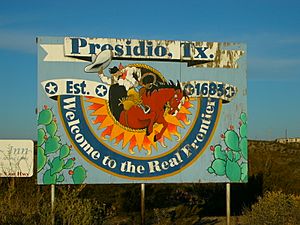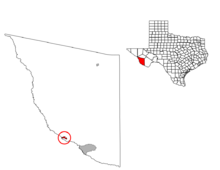Presidio, Texas facts for kids
Quick facts for kids
Presidio, Texas
|
|
|---|---|

Signpost outside the city of Presidio, Texas
|
|

Location of Presidio, Texas
|
|
| Country | United States |
| State | Texas |
| County | Presidio |
| Area | |
| • Total | 2.58 sq mi (6.67 km2) |
| • Land | 2.58 sq mi (6.67 km2) |
| • Water | 0.00 sq mi (0.00 km2) |
| Elevation | 2,579 ft (786 m) |
| Population
(2020)
|
|
| • Total | 3,264 |
| • Density | 1,265.1/sq mi (489.4/km2) |
| Time zone | UTC-6 (Central (CST)) |
| • Summer (DST) | UTC-5 (CDT) |
| ZIP codes |
79845-79846
|
| Area code | 432 |
| FIPS code | 48-59396 |
| GNIS feature ID | 2411489 |
| Website | City of Presidio |
Presidio is a city in Presidio County, Texas, in the United States. It sits right on the Rio Grande River, which forms the border between the U.S. and Mexico. Across the river is the city of Ojinaga, Chihuahua, in Mexico. The name "Presidio" comes from Spanish and means "fortress." In 2020, about 3,264 people lived there.
Presidio is located on Farm to Market Road 170 and U.S. Route 67. It is about 18 miles (29 km) south of Shafter. The city is also about 250 miles (400 km) southeast of El Paso and 145 miles (233 km) northeast of Chihuahua City in Mexico.
Contents
A Look at Presidio's Past
Early Settlements and Spanish Explorers
The area where the Rio Conchos and Rio Grande rivers meet, near Presidio, was settled thousands of years ago. Early people here were hunters and gatherers. By 1200 AD, the Native Americans living here started farming. They lived in small, close-knit villages, which the Spanish later called pueblos. These people were known as the La Junta Indians.
The first Spanish explorers arrived in Presidio in 1535. Álvar Núñez Cabeza de Vaca and his three friends visited a Native American pueblo. They placed a cross on a nearby mountain and named the village La Junta de las Cruces. Later, on December 10, 1582, Antonio de Espejo and his group came to the same spot. They called the pueblo San Juan Evangelista. By 1681, the area was widely known as La Junta de los Ríos, which means "the Junction of the Rivers."
In 1683, Juan Sabeata, the chief of the Jumano people, said he saw a fiery cross on the mountain at Presidio. He asked for a mission to be built at La Junta. In 1684, the settlement became known as La Navidad en Las Cruces. Several missions, like La Navidad en las Cruces and San Francisco de los Julimes, might have been built on the Texas side of the Rio Grande at La Junta.
Changes and New Arrivals
Around 1760, a prison and a military base with 60 soldiers were set up near Presidio. In 1830, the name of the area changed from La Junta de los Rios to Presidio del Norte.
After the Mexican–American War in 1848, white American settlers began to arrive. One of them was John Spencer, who ran a horse ranch near Presidio. Ben Leaton and Milton Faver, who used to hunt for the Mexican government, built their own private forts. The few American settlers who came to this region blended in with the Hispanic population. Today, their descendants mostly speak Spanish.
During the Mexican Revolution, General Pancho Villa often used Ojinaga as his base. He visited Presidio many times.
In 1849, a raid by Comanche people almost destroyed Presidio. In 1850, Native Americans drove away most of the town's cattle. A post office opened in Presidio in 1868, and the first public school started in 1887.
In 1897, President William McKinley appointed George B. Jackson as the customs collector for Presidio. Jackson was an African American man and a former buffalo soldier. He held this important job until he died in 1900. Jackson was a successful businessman from San Angelo. He was considered a very wealthy African American man in Texas during the late 1800s.
Modern Presidio Developments
In 1930, the Kansas City, Mexico and Orient Railway reached Presidio, and the town officially became a city. The population grew from 96 people in 1925 to 1,671 in 1988. However, the number of businesses went down during that time. At the end of 1988, Presidio's population grew quickly. This was partly because many immigrants who had not been officially counted before were now part of an amnesty program. By 1990, the population was 3,422.
The 1959 movie Rio Bravo featured the town of Presidio.
As of 2007, Presidio's economy mostly relies on jobs at the Presidio Independent School District, United States Customs and Border Protection, and local shops. In the past, Presidio had many farms that grew onions and cantaloupes, but these farms stopped operating in the late 1990s.
In 2010, Presidio built the world's largest sodium-sulfur battery. This battery helps provide power to the city when its only connection to the main United States power grid goes down.
Where is Presidio Located?
Presidio is located at 29°33′41″N 104°21′59″W / 29.56139°N 104.36639°W.
The city covers about 2.6 square miles (6.67 square kilometers) of land. Presidio is near where the Rio Conchos and the Rio Grande rivers meet. The Rio Conchos flows northeast from its source in the Sierra Madre mountains in Chihuahua, Mexico. This meeting point of the two rivers is often called "La Junta," meaning "the joining." The rivers create a rich flood plain that is great for farming.
Who Lives in Presidio?
| Historical population | |||
|---|---|---|---|
| Census | Pop. | %± | |
| 1880 | 147 | — | |
| 1930 | 1,202 | — | |
| 1980 | 1,723 | — | |
| 1990 | 3,072 | 78.3% | |
| 2000 | 4,167 | 35.6% | |
| 2010 | 4,426 | 6.2% | |
| 2020 | 3,264 | −26.3% | |
| U.S. Decennial Census 1850–1900 1910 1920 1930 1940 1950 1960 1970 1980 1990 2000 2010 |
|||
Presidio was first listed as a special census area in the 1980 U.S. Census. It was then officially listed as a city in the 1990 U.S. Census.
Presidio's Population in 2020
| Race | Number | Percentage |
|---|---|---|
| White or European American (NH) | 62 | 1.9% |
| Black or African American (NH) | 8 | 0.25% |
| Native American or Alaska Native (NH) | 4 | 0.12% |
| Asian (NH) | 62 | 1.9% |
| Some Other Race (NH) | 1 | 0.03% |
| Mixed/Multi-Racial (NH) | 8 | 0.25% |
| Hispanic or Latino | 3,119 | 95.56% |
| Total | 3,264 |
According to the 2020 United States census, there were 3,264 people living in Presidio. There were 1,394 households and 729 families in the city.
Presidio's Population in 2010
In the 2010 census, there were 5,106 people living in Presidio. There were 1,285 households and 1,033 families. The city had about 1,620 people per square mile (625 per square kilometer). There were 1,541 housing units.
Most of the people in Presidio were White (83.39%). About 94.12% of the population were Hispanic or Latino.
In 2010, 49.3% of households had children under 18. About 62.6% were married couples. The average household had 3.24 people, and the average family had 3.73 people.
The population's age breakdown showed that 37.2% were under 18 years old. The median age was 28 years. This means half the people were younger than 28, and half were older.
The average income for a household in the city was $18,031. For families, it was $19,601. About 43.0% of the population lived below the poverty line. This included 48.3% of those under 18 and 64.5% of those 65 or older.
Mexican Consulate in Presidio
The Consulate of Mexico in Presidio is located in the city. This office helps Mexican citizens and promotes relations between Mexico and the United States.
Learning and Schools in Presidio
Presidio Independent School District
The city of Presidio is served by the Presidio Independent School District. This district includes Presidio Elementary School, Lucy Rede Franco Middle School, and Presidio High School.
In 2011, Shella R. Condino, a physics teacher at Presidio High School, won a special award. She was chosen by the National Aviation Hall of Fame to receive the 2011 A. Scott Crossfield Aerospace Education Teacher of the Year Award. In 2016, Dr. Edgar B. Tibayan, the principal of Lucy Rede Franco Middle School, was named Texas Principal of the Year. He then represented Texas in the search for the National Principal of the Year.
The Presidio Schools have about 1,300 students from pre-kindergarten to 12th grade. Students in Presidio have competed nationally in rocketry. The schools offer many Science, Technology, Engineering, and Math (STEM) classes and activities for all students. The district also has many fine arts programs, including art, band, jazz ensemble, mariachi, and an annual school musical.
All schools in Presidio are fully approved by the Texas Education Agency.
Community College Options
Presidio County is part of the Odessa College District. This means students can attend Odessa College for community college classes.
Things to See and Do in Presidio
Presidio is located three miles north of Fort Leaton State Historic Site. This historic site is a great place to learn about the area's past.
There are also plans to open the Chinati Mountains State Natural Area, which is about 15 miles (24 km) northwest of Presidio along FM 170. Big Bend Ranch State Park is next to Presidio. You can buy permits to enter the park at Fort Leaton. Connecting Presidio south to Lajitas is the Camino del Rio (River Road). This is a 50-mile (80 km) scenic drive that follows the Rio Grande.
Tourists often use Presidio as a quieter way to cross into Mexico at Ojinaga. You can get all the necessary travel permits and Mexican vehicle insurance nearby. Ojinaga is a city with many services for tourists, including places to eat, shop, and stay. Nearby interesting places include Peguis Canyon and the old mining village of Manuel Benavides. You can also take a bus to Chihuahua City every day.
See also
 In Spanish: Presidio (Texas) para niños
In Spanish: Presidio (Texas) para niños

